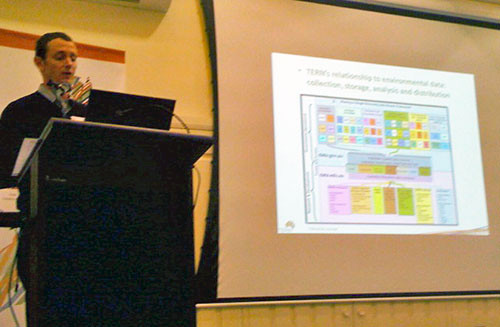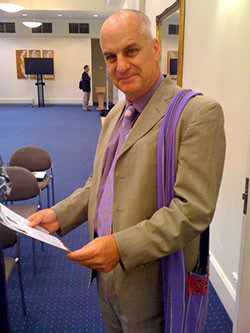TERN workshop
Bill Dennison ·I was asked by Prof. Stuart Phinn from the University of Queensland to give a keynote lecture at the Terrestrial Ecosystem Research Network (TERN) Symposium 2011 in Melbourne, Victoria. There were approximately 100 scientists and resource managers at the symposium held at a conference center near the University of Melbourne. The other keynote speaker was Dr. Steve Kelling from Cornell University. Steve had flown over from New York and was experiencing a healthy case of jet lag, so I appreciated coming only from Brisbane.

Steve gave a stellar talk on the eBird program where avid birders upload observations of birds throughout the United States (with similar programs around the world). The eBird data portal allows users to visualize and analyze very dense data sets. Steve talked about how the eBird program had evolved from a citizen science program into a 'crowd sourcing' program (after a book entitled Crowd Sourcing by Jeff Howe) in which the web functionality provided by eBird attracts huge amounts entries and usage (20 million observations per year). Some of the functionality being developed like forecasting bird migrations or doing data 'mash ups' where disparate data are combined in unique combinations was very exciting.
My talk was entitled "Innovations in scientific synthesis, reporting and governance" and elicited discussion of how to communicate uncertainty, how to maintain quality control using citizen science data, how to overcome risk adverse government agencies, how to publish both science communication products and peer review literature, and how to incorporate traditional knowledge into monitoring programs.
Through a combination of presentations and web portal tutorials we were exposed to the breath of TERN tools and activities. I summarized the six TERN facility portals in a single word each, 1) The AusCover program, which is the remote sensing component of TERN, was SOLID. AusCover developed a portal for terrestrial remote sensing imagery and analysis. 2) The OzFlux program, which is part of a global effort to assess the fluxes of carbon and water between earth and the atmosphere, was ADVANCED. It had a track record of collecting data from observation towers around Australia. 3) The SuperSite program used state agency support to construct facilities at key representative locations to do detailed analysis of static and flux measurements. As it relies on state agency support, it can be described as OPPORTUNISTIC. 4) The EcoInformatics program is being set up to transform unmanaged, disconnected, invisible and single use data sets into managed, connected, visible and multi use data sets. The approach and web portal were being designed to be SMART portals. 5) The Coasts program targets the interface between the marine monitoring program known as Integrated Marine Observing System (IMOS) and the terrestrial monitoring programs. The Australian Ocean Data Network and Coastalcoms websites have large data resources. Due to the interface role and position of Coasts, it is very BROAD. 6) The Australian Centre for Ecological Analysis and Synthesis (ACEAS) is a program focused on the integration of data generated in TERN. ACEAS is in a development phase and is EMERGING, with 10 working groups being set up this year.
Overall, I summarized TERN as being AMBITIOUS, based on the two part definition of ambitious: 1) Having or showing a strong desire and determination to succeed, and
2) Intended to satisfy high aspirations and therefore difficult to achieve. TERN has a lot of good scientists, good partner organizations, and has made entreaties to NGOs, indigenous peoples and citizen scientists. TERN's ambitious program touches on aspects of three major U.S. Science initiatives all supported by the National Science Foundation: 1) National Ecological Observing Network (NEON), 2) Long Term Ecological Research (LTER) program, and The National Center for Ecological Analysis and Synthesis (NCEAS).
I made five recommendations at the end of the symposium as follows:
1) TERN needs to articulate and communicate a broad brush shared vision to stakeholders and policy makers. It has been focused on quietly assembling the nuts and bolts of an integrated network but to attract users and develop a constituency, TERN needs to effectively communicate its vision.
2) TERN clearly needs to educate data providers, and develop incentives and penalties to induce scientists to share their data. The willingness to share was invariably "You can have my data, but . . ." , with conditions about data use are listed after the 'but'. Especially considering that data acquisition is often funded by public monies. The alternative education of policy makers, resource managers and citizen scientists about capabilities and uses of TERN needs to occur.
3) TERN is a long term, capacity building program, and data generated now accrues in value over time. But rather than waiting for decades to get results, TERN needs to set interim targets and celebrate small victories.
4) Moving from ecological data anarchy into an ecological data democracy is something that TERN can aspire to. The quote by Sir Winston Churchill about democracy applies, "Democracy is the worst form of government, except for all the rest that have been tried.". Setting up and maintaining democratic processes and organizations will be needed and some champions need to be fostered.
5) A prevailing issue of scale permeates every aspect of TERN. TERN has a good nested series of observation scales, leading to the question, "How are you going to scale up observations across temporal, spatial and complexity scales?"
Personally, I learned a lot, met interesting people, and enjoyed a diverse program in a nice setting. The whole workshop was only two days, and there were multiple opportunities to interact with TERN staff, including a very nice dinner at Melbourne University. I made a strong case for sharing data without strings attached and told people about the Chesapeake Bay Program and the Maryland Biological Stream Survey data portals that attract people from all over the world to download, analyze and interpret data. This represents free labor and fresh insights to the organizations posting the data.

About the author
Bill Dennison

Dr. Bill Dennison is a Professor of Marine Science and Vice President for Science Application at the University of Maryland Center for Environmental Science.

